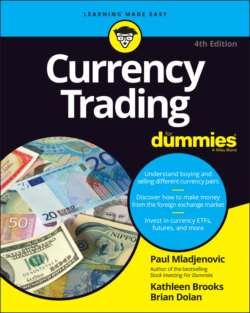Читать книгу Currency Trading For Dummies - Kathleen Brooks - Страница 22
Executing the Trading Plan from Start to Finish
ОглавлениеThe start of any trade comes when you step into the market and open up a position. How you enter your position, how you execute the first step of your trading plan, can be as important as the trade opportunity itself (see Chapter 10). After all, if you never enter the position, the trade opportunity will never be exploited. And probably nothing is more frustrating as a trader than having pinpointed a trade opportunity, having it go the way you expected, but having nothing to show for it because you never put the trade on.
The effort and resources you invest in researching, monitoring, and analyzing the market come to a concrete result when you open a trade. This process is made easier by formulating a personal trading system, with trigger points and setups to help you enter the trade. Placing the trade is just the beginning.
Just because you have a trading plan doesn’t mean the market is necessarily going to play ball. You need to be actively engaged in managing your position to make the most of it if it’s a winner and to minimize the damage if the market isn’t going in your favor.
Active trade management is also critical to keeping more of what you make in a trade. In our experience, making money in the forex market is not necessarily the hard part. More often than not, keeping what you’ve made is the really hard part.
You need to stay on your toes, and keep thinking about and monitoring the market while your trade is still active. The market will always be moving, sometimes faster than at other times, and new information will still be coming into the market. In Chapter 11, we look at several different ways you can monitor the market while your trade is open, as well as how and when you should adjust your trade strategy depending on events and time.
Exiting each trade is the culmination of the entire process, and you’re either going to be pleased with a profit or disappointed with a loss. Every trade ends in either a profit or a loss (unless you get out at the entry price); it’s just the way the market works. While your trade is still active, however, you’re still in control and you can choose to exit the trade at any time.
Even after you’ve exited the position, your work is not done. If you’re serious about currency trading as an enterprise, you need to review your prior trade for what it tells you about your overall trading style and trade execution. Keeping a record of your trading history is how you stay focused, learn from your mistakes, and avoid lapses in discipline that could hurt you on your next trade. Only then is it time to move on to the next trading opportunity. (And don’t forget the last step regarding your trades: the potential tax bite. Find out more in Chapter 12.)
By the way, there is more than one way to make a buck in the world of currencies; currency trading isn’t the only game in town. For some, it’s too complicated a game anyway. But fear not! I (coauthor Paul) invite you to peruse Part 4, which could open up a new world of currency opportunities. I personally like currency exchange-traded funds (ETFs) and options on them for some uncomplicated trading opportunities. Currency ETFs are in Chapter 13, while options are covered in Chapter 15. Don’t forget currency futures (see Chapter 14) and the popular new kid on the block, cryptocurrencies — they are in Chapter 16.
